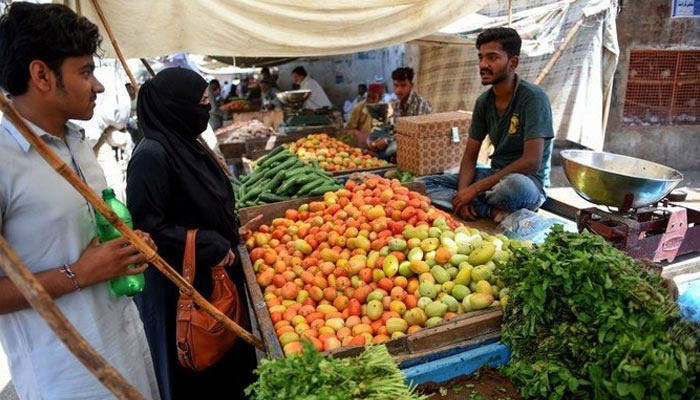Inflation hits 48-year high in January
Pakistan’s inflation created a new record in January 2023 and reached the highest level after 1975
ISLAMABAD: While mired in a terrible economic crisis, Pakistan’s inflation created a new record in January 2023 and reached the highest level after 1975, mainly due to supply constraints as thousands of containers of food items, raw materials and equipment are stuck at ports after the cash-strapped government curtailed imports due to a shortage of dollars in the country.
Consumer Price Index (CPI) inflation in January 2023 accelerated to 27.55 per cent from 24.47 percent a month earlier, as the unprecedented surge in food items’ prices in the month jacked up the general inflation. In May 1975, the CPI inflation was 27.77 percent.
The average inflation in July-Jan 2022/23 was recorded at 25.4 per cent against only 10.26 per cent in the same period of FY22, according to the Pakistan Bureau of Statistics (PBS) on Wednesday. The core inflation (excluding the food and energy components) also peaked in the month under review since 2011. It indicates that the State Bank of Pakistan (SBP) will keep the discount rate elevated in the coming monetary policy review.
On January 23, the central bank raised the policy rate by 100 basis points to 17 per cent — the highest since 1998 — to help stabilise the economy. High inflation has become a nightmare amid the financial crunch and insufficient supplies. It is eroding the political capital of the 13-party coalition government led by the PMLN. It is not only affecting ordinary people but also industries and businesses due to costly bank financing. The inflation rate in Pakistan averaged 8.05 per cent from 1957 until 2023, reaching an all-time high of 37.8 per cent in December 1973 and a record low of minus 10.32 per cent in February 1959.
According to the Pakistan Bureau of Statistics (PBS) monthly inflation bulletin, the village population was hard hit by inflation than in cities, as inflation in rural Pakistan was much higher. It is to be noted that nearly two-thirds of Pakistanis are living in rural areas.
Urban inflation increased by 24.38 percent yearly in January 2023 as compared to 21.6 per cent in December and 13 per cent in January 2022. Whereas, the rural CPI increased 32.3 percent on a year-on-year basis in January 2023 as compared to an increase of 28.8 per cent in the previous month and 12.9 per cent in January 2022. Over the last month, urban inflation increased by 2.4 per cent and rural by 3.6 per cent.
National food inflation, which occupies 34.58 weightage in the CPI basket, jumped to 42.9 per cent in January, the highest since 2011. In December 2022, food inflation was 35.5 per cent.
The food inflation in villages was recorded at 46.8 per cent while in urban centers it was at 39.5 per cent. The biggest increase in onion prices year on year was by 469 percent, chicken 83.3 per cent, wheat 78.4 per cent, rice 65 per cent, wheat flour 61 percent, gram whole 50.5 per cent, moong pulse 46 percent, gram pulse 44.5 per cent, besan 43 per cent, mustard oil 42.3 per cent, mash pulse 37 per cent, fresh fruits 35.3 per cent, cooking oil 31.5 percent, fresh milk 29.3 percent, vegetable ghee 28.5 percent, tomatoes 22.4 percent, fish 22.3 percent, masoor pulse 22 percent, meat 20 percent, fresh vegetables 8.4 percent.
Independent economists believe that in the coming months, due to the sharp devaluation of the rupee, petroleum products’ prices, and expected upward adjustment in electricity and gas tariffs under the International Monetary Fund (IMF) demand for cutting down the ballooning circular debt in the energy sector would further increase inflationary pressure.
Inflation, which is considered an ‘unseen tax’, eats up the purchasing power of money and savings. In general terms, this high inflation indicates that the rupee’s power to purchase a certain item has dwindled by nearly one-third compared to last year.
The core inflation (excluding the food and energy components) also increased over the previous month. From 2010 to 2023, core inflation averaged 7.74 percent with the highest reading of 15.4 percent in the month under review [January 2023] and the lowest of 3.4 percent in Sept 2015. In December 2022, the core inflation was 14.9 percent.
Urban core CPI increased by 15.4 percent on a YoY basis in January 2023 against an increase of 14.7 percent in the previous month and 8.2 percent in January 2022. Likewise, the rural core CPI increased 19.4 percent on a YoY basis in January 2023 as compared to 19 percent in the last month. On a monthly basis, urban core inflation is up by 1.4 percent and rural by 1.5 per cent.
House rent and utility charges (water, electricity, gas, and fuels) occupy nearly a quarter of CPI. Inflationary pressure in this group increased to 7.83 percent in January 2023 against 6.95 percent in December 2022.
Similarly, in January 2023, transportation charges were 39.1 percent costlier, alcoholic beverages and tobacco 36.3 percent, and restaurants and hotels 30.1 per cent over a year ago.
Likewise, furnishing and household equipment maintenance charges went up 29.9 percent, and recreation and culture 44 percent. Clothing and footwear costs also increased by 16.8 percent, health charges by 18.7 percent, and education charges by 10.6 percent over January 2022. Another indicator of inflation, the Wholesale Price Index (WPI) or producer price also increased by 28.5 percent in January 2023, the highest in three months, from 27.1 percent in December 2022 and an increase of 24 percent in January 2022.
Prices grew further for agriculture forestry & fishery (24 pc against 19.6pc in December) and food, beverages, tobacco, textiles & leather products (23.3pc vs 20.9pc) whereas, inflation slowed for transportable goods (34.9 pc vs 35.7pc); ores/minerals, electricity, gas & water (12.8pc vs 17.1pc), and metal products, machinery & equipment (66pc vs 68.2pc).
The weekly sensitive price indicator (SPI) also increased 30.5 percent in the month under review as compared to an increase of 27.8 percent last month and 20.9 percent in January 2022.
While having a cursory look at the CPI data, in the pan of one month the prices of chicken increased 24.6 percent, wheat 16.5 percent, rice 14.2 percent, wheat flour 13.2 percent, wheat products 11.7 percent, onions 9.7 percent, bakery & confectionery 5.4 percent, fresh fruits 5.2 percent, eggs 4.4 percent, moong and masoor pulses by 4 percent, gram pulse, beans, and gram whole by 3 percent, mash pulse by 2.5 percent and fresh milk and fish by 2 percent. However, the prices of tomatoes declined by 39 percent, potatoes by 26 percent, and vegetable ghee by 1.2 percent over the previous month.
Year on year, among non-food items, stationery prices in January 2023 increased by 47.4 percent, transport services by 30 percent, motor vehicle accessories by 29.3 percent, motor vehicles by 28 percent, marriage hall charges by 20 percent, household textiles by 14.6 percent, construction wage rates 14.2 percent, education 10.4 percent, house rent 5.4 percent, water supply 5 percent and newspapers price up by 4.2 percent over January 2022.
-
 Chevy Chase Shares Disappointment After 'SNL50: The Anniversary Special' Snub
Chevy Chase Shares Disappointment After 'SNL50: The Anniversary Special' Snub -
 Samuel L. Jackson's Old Movie Found New Life: Here's How
Samuel L. Jackson's Old Movie Found New Life: Here's How -
 Nobel Prize Snub Hardens Donald Trump's Tone On ‘peace’
Nobel Prize Snub Hardens Donald Trump's Tone On ‘peace’ -
 What's Prince Harry's Case Against The Daily Mail's Publisher?
What's Prince Harry's Case Against The Daily Mail's Publisher? -
 'Matilda' Star Mara Wilson Breaks Silence On AI's 'deepfake Apocalypse' After Being Abused
'Matilda' Star Mara Wilson Breaks Silence On AI's 'deepfake Apocalypse' After Being Abused -
 Meghan Markle 'ruined' Prince Harry's Life?
Meghan Markle 'ruined' Prince Harry's Life? -
 Super Bowl Halftime Show Gets Another Attraction Besides Bad Bunny
Super Bowl Halftime Show Gets Another Attraction Besides Bad Bunny -
 Princess Irene's Coffin Arrives For Funeral Rites
Princess Irene's Coffin Arrives For Funeral Rites -
 Sean Penn's Gay Role Interview Resurfaces After LA Stroll With Valeria Nicov
Sean Penn's Gay Role Interview Resurfaces After LA Stroll With Valeria Nicov -
 FBI’s Most Wanted Caught After 10 Years In Mexico
FBI’s Most Wanted Caught After 10 Years In Mexico -
 Inside Kate Middleton's Meaningful Nod To Own Milestone
Inside Kate Middleton's Meaningful Nod To Own Milestone -
 Zachary Levi 'running' To Build His Future In Politics?
Zachary Levi 'running' To Build His Future In Politics? -
 Andrew Lands In Fresh Major Trouble After Princess Eugenie Left Him 'devastated'
Andrew Lands In Fresh Major Trouble After Princess Eugenie Left Him 'devastated' -
 Colleen Hoover Shares Major Update About Cancer Treatment
Colleen Hoover Shares Major Update About Cancer Treatment -
 UK Starmer Rules Out US Trade War, Calls For ‘calm Diplomacy’ Over Greenland
UK Starmer Rules Out US Trade War, Calls For ‘calm Diplomacy’ Over Greenland -
 Billy Bob Thornton Clears The Air About His Exit From 'Landman'
Billy Bob Thornton Clears The Air About His Exit From 'Landman'




